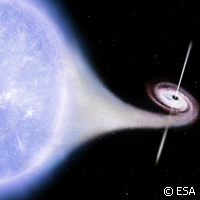How hot matter is not always doomed
The Integral gamma-ray observatory of the European Space Agency (ESA) recently spotted super hot matter just a millisecond before it got lost in a black hole. But is the matter done for? Astronomers believe some of the matter may be making a great escape. Experts say being close to a black hole would play with anyone's nerves. Particles and radiation are in great supply in space, and vast storms of particles are doomed at close to the speed of light. The result is a boost in temperature, as high as millions of degrees. Under normal circumstances, particles cross the final distance within just a millisecond. But a tiny fraction of them may actually be able to be 'saved.' The new Integral observations have allowed the scientists to determine that this chaotic region is threaded by magnetic fields. It is the first time ever that astronomers have succeeded in identifying magnetic fields in the vicinity of a black hole. Integral shows that they are highly structured magnetic fields that are creating an escape tunnel for some particles that were done for. Philippe Laurent of the Centre d'Etudes Nucléaires de Saclay (CEA Saclay) in France and colleagues made the discovery by investigating the nearby black hole, Cygnus X-1, which is tearing a companion star to pieces and feeding on its gas. Their work shows that the magnetic field is so strong that it can tear away particles from the black hole's gravitational hold and funnel them outwards. So jets of matter end up being spewed into space. The researchers say the particles in these jets are being drawn into spiral trajectories as they climb the magnetic field to freedom. This is impacting a property of their gamma-ray light, what experts call polarisation. A gamma ray is identified as a wave whose orientation is known as its polarisation. Fast particles spiralling in a magnetic field generate a kind of light, what astronomers call 'synchrotron emission', which displays a characteristic pattern of polarisation. It is this polarisation that the researchers discovered in the gamma rays. This was no easy feat. 'We had to use almost every observation Integral has ever made of Cygnus X-1 to make this detection,' Dr Laurent says. Repeated observations of the black hole, over a 7-year period, amounted to more than 5 million seconds of observing time, which is like snapping one image with an exposure time of over 2 months. The team compiled everything together to generate such an exposure. 'We still do not know exactly how the infalling matter is turned into the jets. There is a big debate among theoreticians; these observations will help them decide,' explains Dr Laurent. In the past, researchers identified jets around black holes by using radio telescopes. But they were unable to see the black hole in sufficient detail to determine how close to the black hole the jets originate. And this is where this study differs. 'This discovery of polarized emission from a black hole jet is a unique result demonstrating that Integral, which is covering the high-energy band in ESA's wide spectrum of scientific missions, continues to produce key results more than eight years after its launch,' comments Christoph Winkler, ESA Integral Project Scientist.For more information, please visit: European Space Agency (ESA):http://www.esa.int/esaCP/index.htmlCentre d'Etudes Nucléaires de Saclay:http://www.cea.fr/le_cea/les_centres_cea/saclay
Countries
France



